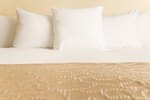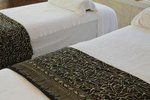
The larvae of carpet beetles and clothes moths eat clothes -- wool in particular. While not every species of either of these creatures is black, many are dark in appearance. Controlling the destructive bugs centers mostly around cleaning and keeping your vulnerable clothes sealed away. Pesticides usually aren't needed.
Carpet Beetles
If you find black oval bugs on your clothes, you're likely looking at adult carpet beetles. Carpet beetles don't just scrounge for food in the carpet -- they also eat clothes, but only in larval form. Adults eat nectar and pollen, but you may spot them on your clothes occasionally, especially if a female is laying eggs. Black carpet beetle larvae look somewhat like worms and take on a brownish to black appearance. Varied carpet beetle larvae and furniture carpet beetle larvae are more oval in shape and either narrower in the front than the back or vice versa. The larvae look brownish-reddish, and their bodies are covered in hair. When it comes to your clothes, only those made from animals or their products are in danger -- things like wool and silk.
Clothes Moths
Adult clothes moths do not feed on clothing, but their larvae will eat tiny holes in your fabrics. Two kinds exist: case-making clothes moths and webbing clothes moths. The larvae of both types are cream colored, but case-making larvae create silk cases, which they feed from and scurry into when frightened. Webbing clothes moths also spin silk occasionally, but they use it as a temporary feeding tube and discard it. Case-making larvae keep their tubes with them until they become adults. Both types of tubes match the color of the larvae's food -- so if they're feeding on dark fabrics, they could appear blackish. Adults typically look light in color. They generally feed on wool fabrics only.
Prevention
Regular and thorough cleaning is key to preventing both carpet beetles and clothes moths. This is especially important if you have pets, because they shed hair that both beetle and moth larvae eat. When you vacuum, pay special attention to hard-to-reach areas -- such as baseboards, under your furniture, behind desks and in the crevices of your couch. Larvae usually take about a little over a week to two weeks to hatch. As long as you vacuum more often than that, you'll suck up the little buggers before they hatch. For carpet beetles, store clothes made from animal products in airtight containers. For carpet moths, you need to store only those clothes made entirely or partly of wool.
Elimination
If carpet beetles or clothes moths have infested your clothes or other washable items, wash and, on the hottest setting, dry them. Dry-cleaning or ironing them will kill the insects. Steam-cleaning your carpet will rid the pests from there. Trash infested items you don't need. The Illinois Department of Health website says freezing items in a sealed plastic bag for several weeks at 5 degrees Fahrenheit or for two to seven days at -20 degrees Fahrenheit will kill larvae and adults. Regular cleaning in addition to employing these elimination methods should keep you from having to apply pesticides. If you can't eliminate carpet beetles or clothes moths, contact a pest control specialist.
References
Photo Credits
-
Jupiterimages/Comstock/Getty Images
Writer Bio
Located in Pittsburgh, Chris Miksen has been writing instructional articles on a wide range of topics for online publications since 2007. He currently owns and operates a vending business. Miksen has written a variety of technical and business articles throughout his writing career. He studied journalism at the Community College of Allegheny County.




